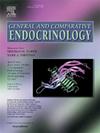应激对沼泽鹿(Blastocerus dichotomus)粪便糖皮质激素和雄激素代谢谱及鹿角状态的影响
IF 1.7
3区 医学
Q3 ENDOCRINOLOGY & METABOLISM
引用次数: 0
摘要
糖皮质激素对鹿群中生殖激素和鹿角周期的影响仍然知之甚少,特别是在热带物种中。大多数新热带鹿,如沼泽鹿(Blastocerus dichotomus),缺乏明确的繁殖季节或鹿角阶段与生殖状态之间的明确联系。此外,关于应激对雄激素水平和鹿角发育影响的相互矛盾的数据强调了进一步研究的必要性。我们评估了应激对圈养沼泽鹿粪便糖皮质激素代谢物(fgm)、粪便雄激素代谢物(FAMs)和鹿角状态的影响。19只雄性在转移到新的繁殖地点后进行了隔离,每周监测鹿角状况。使用EIA分析了来自17个个体的每日粪便样本,以测量FAM和FGM浓度。在12只鹿角发育完全的动物中,近60% % (n = 7)经历了鹿角铸造,这在该物种中是不寻常的同步现象。FAM与女性生殖器切割水平呈正相关(p本文章由计算机程序翻译,如有差异,请以英文原文为准。
Effect of stress on profiles of fecal glucocorticoid and androgen metabolites and antler status in marsh deer (Blastocerus dichotomus)
The influence of glucocorticoids on reproductive hormones and antler cycles in cervids remains poorly understood, particularly in tropical species. Most Neotropical deer, like the marsh deer (Blastocerus dichotomus), lack a defined breeding season or a clear link between antler stage and reproductive status. Furthermore, conflicting data regarding stress impacts on androgen levels and antler development underscore the need for further research. We evaluated the effects of stress on fecal glucocorticoid metabolites (FGMs), fecal androgen metabolites (FAMs) and antler status in captive marsh deer. Nineteen males underwent a quarantine after being transferred to a new breeding site, with antler status monitored weekly. Daily fecal samples from 17 individuals were analyzed using EIA to measure FAM and FGM concentrations. Among 12 animals with fully developed antlers, nearly 60 % (n = 7) experienced antler casting, an unusual synchrony for this species. A positive correlation was found between FAM and FGM levels (p < 0.001; r = 0.40). We compared FAM and FGM levels between juveniles and adults, as well as among the antler categories. Adults exhibited 1.2-fold higher FGM levels than juveniles, with no differences in FAM levels. Males with hard antlers showed the highest FAM levels, while FGM levels were highest in males with velvet antlers. We hypothesize that intense stress negatively affected antler retention, leading to antler casting. Our findings suggest that stressful stimuli may trigger adrenal secretion of glucocorticoids and androgens, providing insights into the relationship between stress and antler dynamics in marsh deer.
求助全文
通过发布文献求助,成功后即可免费获取论文全文。
去求助
来源期刊

General and comparative endocrinology
医学-内分泌学与代谢
CiteScore
5.60
自引率
7.40%
发文量
120
审稿时长
2 months
期刊介绍:
General and Comparative Endocrinology publishes articles concerned with the many complexities of vertebrate and invertebrate endocrine systems at the sub-molecular, molecular, cellular and organismal levels of analysis.
 求助内容:
求助内容: 应助结果提醒方式:
应助结果提醒方式:


